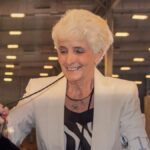Interview with Sandra McCrady, Breeder of Aquilon Great Pyrenees
- Please tell us a little bit about yourself. Where do you live? How many years in dogs? How many years as a breeder? What is your kennel name?
- What is your “process” for selecting show puppies? Performance puppies?
- In your opinion, is your breed in good condition overall? Any trends that warrant concern?
- As a Preservation Breeder, can you share your thoughts on the sport today? How’s the judging these days? What do you think about the number of shows?
- In your opinion, is social media good for the sport? Is it harmful?
- What are the biggest challenges facing the dog show community as a whole today and how can these be addressed?
- What are some of the positive changes you’ve seen in the sport over the past decade?
Sandra McCrady
1. I’ve always lived in the Colorado front range. Until recently, I’ve usually supported more dogs than are legal within city limits, so we have enjoyed country life. My dogs have always carried the kennel name AQUILON, which is registered. I joined GPCA in 1973 and have celebrated over 50 years of membership.
2. My puppies and young adults are bred and trained for multiple purposes from the time the parents are selected. It is easy to say “this is a show puppy” or “that one isn’t.” It is harder to select a fine Obedience dog or a Service/Therapy Dog. Selecting for function starts long before the whelping box is set up; even before you select parents, because temperament is determined genetically as much as conformation is.
I do a breadth pedigree of the prospective pair and look for characteristics that complement my purpose for the litter. I’ve been fortunate enough to have seen many relatives of my breeding dogs. Not only have I seen the fine show specimens but I’ve seen the faults they’ve produced. I’m looking for faults I can live with but are okay for companions, and temperaments that permit even the most worthy show dog to be a Therapy Dog. For myself, I want the added intelligence and calmness for a Mobility Assistance Dog.
Once the pair is selected and the litter has arrived, the puppies are trained using methods for military super dogs. It takes a lot of time to do these exercises every day, but it is worth every minute. By the time the puppies are seven weeks old, I can assess their suitability for various roles they may have as adults.
To do assistance, the dog must be mentally and physically stable and be willing to serve their owner. It is difficult, sometimes boring work for a dog, so they have to be willing. My previous Service Dog had every characteristic needed, but she let me know she thought I was a bit unsound as a partner and definitely asked a lot of her when she was bored. I could see it in her eyes. My current Service Dog is in training and still thinks I’m perfect for him and will help in any way he can.
3. I believe the breed is more physically and mentally sound than they were when I started breeding. The community has done well with selecting for these and should be praised. I would warn that lifespan and overall health seem to be suffering in our breeding programs. I’m not sure if this is changing environment or genetic issues that need to be addressed. No matter the role the dog is to fill, a lifespan of over 12 years should be expected. That, without serious medical issues. I’m hearing of many dogs that are gone well before 10 years old, usually to a cancer. Not good.
4. As a Preservation Breeder, I enjoy the sport. I want to show off what I produce, but I also consider it is now my turn to assist new people to get involved and enjoy all the activities. I’m pleased with the Professional Handlers taking time to assist new people and would ask all breeders to do the same. Make it fun and educational.
As a low entry breed, I’m pleased to see most judges still appreciate a good dog. The number of shows indicates interest. I hope we can attract more people to attend.
5. Social media is a necessary component. It can be good or evil, so I remind people to use good sportsmanship when typing. It reflects on you as well as the sport. May it help to educate people and add to the commitment for our breed.
Social media is a necessary component. It can be good or evil, so I remind people to use good sportsmanship when typing.
6. The biggest challenge I see today is attracting the next generation to become involved. New puppy buyers, new Junior Handlers, new breeders. They need to be helped and made to see the benefits of participating in shows. Eventually, they will be those preserving the heritage we hand them for dogs in general and our Pyrs in particular. Without them, we may lose this lovely breed.
7. What are some of the positive changes I’ve seen in the sport over the past decade? I’ve seen more people entering the Amateur-Owner-Handler and Bred-By Classes, and this is a good thing. It presents our commitment to the public. Cluster shows are also drawing more people to gather and spend a weekend seeing many dogs and talking to other folks. This is a learning event! We need to plan pot lucks and let topics vary. Share the spirit!








